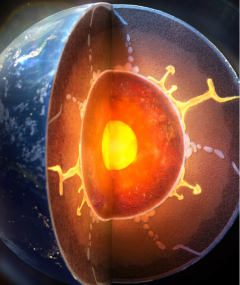Overview
Beneath the Earth’s surface lies a transformative zone known as the core-mantle boundary, where materials shift remarkably from silicate to metal. Despite this significant change, the chemical interactions within this transition have mainly remained elusive.
Decades ago, seismologists delving into the depths of our planet stumbled upon a mysterious layer, merely a few hundred kilometres thick, now commonly dubbed the E prime layer. Until recently, the origins of this enigmatic stratum had puzzled researchers.

In a groundbreaking revelation, recent research unveils the journey of water from Earth’s surface penetrating deep into the planet, shedding light on its profound impact on the outermost realm of the metallic liquid core.
Decoding the Discovery
The Earth’s dynamic crust comprises shifting tectonic plates engaged in grinding and sliding. Within these intricate movements, subduction zones have emerged as conduits, ferrying water to the far reaches of the lower mantle.
This water journey descending a staggering 2,900 kilometres (1,800 miles) below our feet arrives at the crucial point of the core-mantle boundary. At this depth, something remarkable happens – a chemical transformation triggered by the interaction of water with the Earth’s core materials.
A collaborative effort involving researchers from South Korea, the United States, and Germany has unveiled this intricate discovery, illuminating the creation of a top core layer enriched with hydrogen and the descent of silica into the lower mantle.

Scientists have unveiled a hidden dynamic within the Earth’s depths in a revelation that challenges conventional wisdom. Deep beneath the planet’s surface, water from Earth’s exterior has found a way to infiltrate its core, ushering in transformative changes to the outermost region of the metallic liquid core.
For years, the prevailing notion held that there was minimal material exchange between the Earth’s mantle and core. However, recent experiments conducted under extreme pressure paint a different narrative.
The scientific team conducted experiments, including minds from Arizona State University—Dan Shim, Taehyun Kim, and Joseph O’Rourke from the School of Earth and Space Exploration. Employing high-temperature and -high-pressure laser-heated diamond-anvil cell techniques, they replicated the extreme conditions prevailing at the core-mantle boundary. The revelation emerged that subducted water undergoes a transformative chemical interplay with core materials.
The result?
Subducted water undergoes a chemical reaction with core materials, creating a hydrogen-rich layer while depleting silicon-like, reshaping the top layer of the Earth’s outer core into a film-like structure. Simultaneously, this reaction produces silica crystals that rise and seamlessly blend into the conditions of the mantle, right at the Earth’s core–mantle boundary.
Who knew water could play such an intriguing role?
Understanding the Inner Alchemy of Earth’s Core
The Earth’s magnetic field, a crucial shield against solar winds and radiation, owes its existence to the outer core’s mixture of iron and nickel. Understanding Earth’s core’s inner workings and evolutionary trajectory is paramount in unravelling the mysteries that have shaped our planet over time.
Uncertainty shrouds the chemical exchanges in this critical zone at the core-mantle boundary, where the composition transitions abruptly from silicate to metal. Decades ago, seismologists delving into the Earth’s dense interior stumbled upon a puzzling thin layer, the proposed ‘E prime’ layer, measuring just a few hundred kilometres thick. Until now, its origin has remained a mystery.
The team suggests that the chemical exchange between the core and mantle over gigayears of deep water transport may have formed the proposed E prime layer.
Seismic observations hinted at unusual features in this altered liquid metallic layer, suggesting reduced density and slower seismic speeds. These anomalies are believed to involve varying concentrations of light elements, such as hydrogen or silicon.
The challenge arose in reconciling the seismic observations with the dynamic stability of the E prime layer—a proposed solution involved altering the concentration of different light elements. However, scientists were unaware of a process facilitating such an exchange.

The results demonstrated by this groundbreaking experiment show that water subducted into Earth’s core undergoes a transformative chemical reaction with core materials. This reaction turns the outer core into a hydrogen-rich film. It disperses silica crystals that ascend and seamlessly integrate into the mantle. This discovery deepens our understanding of Earth’s core and mantle.
Also, this newly identified layer, marked by reduced density and seismic speed, aligns seamlessly with seismic wave observations. Researchers speculate that it could significantly influence the deep water cycle, hinting at a global water cycle far more complex than previously envisioned.
Shim, one of the team members, suggests that the discovery, coupled with their earlier observation of diamonds forming from water reacting with carbon in iron liquid under extreme pressure, indicates a more dynamic core-mantle interaction, implying significant material exchange.
Published in Nature Geoscience, this study sure does mark a significant milestone in unravelling the complexities that lie beneath our feet.












Comments 1